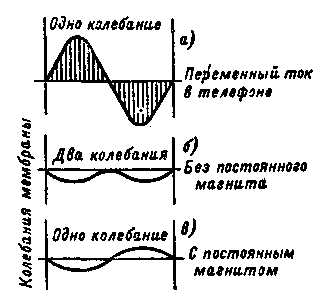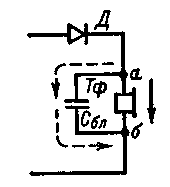
|
|
ENCYCLOPEDIA OF RADIO ELECTRONICS AND ELECTRICAL ENGINEERING Headset. Encyclopedia of radio electronics and electrical engineering
Encyclopedia of radio electronics and electrical engineering / Beginner radio amateur The telephone is the third, last link of the detector receiver, which, figuratively speaking, "gives out the finished product" - sound. This is one of the oldest electrical appliances, which has retained its main features almost unchanged to this day. For detector receivers, headphones of the type TON-1, TON-2 are used. These are two phones connected in series, held on the headband. Let's unscrew the cover of one of the phones (Fig. 1). Under it is a round tin plate - a membrane. Carefully removing the membrane, we will see two coils mounted on plates protruding from the bottom of the case.
These are permanent magnet pole pieces pressed into the bottom of the case. The coils are connected in series, and their extreme conclusions are soldered to the rods, to which a cord with single-pole plugs is connected from the outside with clamping screws. How does the phone work? The membrane that creates the sound is located near the pole pieces of the magnet and rests on the sides of the case (Fig. 2). Under the influence of the magnet field, it bends a little in the middle, but does not touch the pole pieces of the magnet (Fig. 2 - solid line). When current flows through the coils of the phone, it creates a magnetic field around the coils, which interacts with the field of the permanent magnet. The strength of this single magnetic field, and hence the force of attraction of the membrane to the pole pieces, depends on the direction of the current in the coils. With one current direction, when the directions of the magnetic lines of force of the coils and the magnet coincide and their fields add up, the membrane is more strongly attracted to the poles of the magnet (in Fig. 50 - the lower dashed line). With a different direction of current, the lines of force of the coils and the magnet are directed oppositely and the total field becomes weaker than the field of the magnet. In this case, the membrane is weaker attracted by the pole pieces and, straightening, moves away from them somewhat (Fig. 50 - upper dashed line). If an alternating current of sound frequency is passed through the telephone coils, the total magnetic field will either increase or weaken, and the membrane will either approach the pole pieces of the magnet, then move away from them, i.e., oscillate with the frequency of the current. As it oscillates, the membrane will create sound waves in the surrounding space.
At first glance, it may seem that a permanent magnet is not needed in the phone: the coils can be put on an iron, non-magnetized shoe. But it is not. And that's why. An iron shoe magnetized only by the current in the coils will attract the membrane whether the current flows through the coils in one direction or the other. This means that in one period of alternating current, the membrane will be attracted during the first half-cycle, move away from it, and be attracted again during the second half-cycle, i.e., in one period of alternating current (Fig. 3, a), it will make two oscillations (Fig. 3 ,b).
If, for example, the current frequency is 500 Hz, then the telephone membrane will make 1x500=2 vibrations in 1000 s and the sound will be distorted - it will be twice as high. It is unlikely that such a phone will suit us. With a permanent magnet, the situation is different: with one half-cycle, the magnetic field is strengthened - the already attracted membrane will bend even more; at another half-cycle, the field weakens and the membrane, straightening, moves further away from the poles of the magnet. Now let's analyze this question: why is a blocking capacitor connected in parallel with the phone? What is its role? The electrical capacitance of the blocking capacitor is such that high-frequency currents freely pass through it, and it provides significant resistance to audio-frequency currents. The telephone, on the other hand, passes audio frequency currents and has great resistance to high frequency currents. In this section of the detector circuit, the high-frequency pulsating current is divided (in Fig. 4 - at point a) into components, which then go: high-frequency - through the blocking capacitor, and low-frequency - through the telephone. Then the components are connected (in Fig. 4 - at point b) and then again go together.
The purpose of the blocking capacitor can be explained as follows. The telephone, due to the inertness of the membrane, cannot respond to every high-frequency current pulse in the detector circuit. This means that for the phone to work, it is necessary to somehow "smooth out" the high-frequency pulses, "fill in" the current dips between them. This problem is solved using a blocking capacitor as follows. Individual high-frequency pulses charge the capacitor. In the moments between pulses, the capacitor is discharged through the telephone, thus filling in the "gaps" between pulses. As a result, a current flows through the phone in one direction, but changing in magnitude with an audio frequency, which is converted by the phone into sound. Briefly, the role of the blocking capacitor can be said as follows: it filters the low-frequency component of the current rectified by the diode, that is, it “cleanses” the audio frequency current from the high-frequency component. Why did the detector receiver work during the very first experiment, when there was no blocking capacitor? It was compensated by the capacitance concentrated between the wires of the cord and the turns of the telephone coils. But this capacitance is much less than the capacitance of a specially connected capacitor. In this case, the current through the detector is less than in the presence of a blocking capacitor, and the transmission is less audible. This is especially noticeable when receiving distant stations. The quality of a phone's performance is judged mainly in terms of its sensitivity - its ability to respond to slight fluctuations in electric current. The weaker the vibrations to which the phone responds, the higher its sensitivity. The sensitivity of a telephone depends on the number of turns in its coils and the quality of the magnet. Two phones with exactly the same magnets, but with coils containing an unequal number of turns, are different in sensitivity. The best sensitivity will be the one in which coils with a large number of turns are used. The sensitivity of the phone also depends on the position of the membrane relative to the pole pieces of the magnet. The best sensitivity will be in the case when the membrane is very close to the pole pieces, but, vibrating, does not touch them. Phones are usually divided into high-resistance - with a large number of turns in the coils, and low-resistance - with a relatively small number of turns. Only high impedance telephones are suitable for the detector receiver. The coils of each telephone type TON-1, for example, are wound with enameled wire 0,06 mm thick and have 4000 turns. Their DC resistance is about 2200 ohms. This number, which characterizes the phones, is stamped on their cases. Since the two phones are connected in series, their total resistance is 4400 ohms. The DC resistance of low-resistance phones can be 50-60 ohms. How to check the health and sensitivity of headphones? Hold them to your ears. Moisten the plugs at the end of the cord with saliva, and then touch them to each other - a faint click should be heard in the phones. The stronger this click, the more sensitive the phones. Clicks are obtained because the wet contact between the metal plugs is a very weak source of current. A more rough check of phones is done with a battery for a flashlight. When connecting phones to the battery and disconnecting from it, sharp clicks are heard. If there are no clicks, then somewhere in the coils or cord there is a break or poor contact. Publication: N. Bolshakov, rf.atnn.ru
Traffic noise delays the growth of chicks
06.05.2024 Wireless speaker Samsung Music Frame HW-LS60D
06.05.2024 A New Way to Control and Manipulate Optical Signals
05.05.2024
▪ NVIDIA began to assemble some video cards on its own ▪ Technology for remanufacturing old engines
▪ section of the website Experiments in Physics. Selection of articles ▪ article The furnace pumps water. Tips for the home master ▪ How many parts are soccer ball tires made from? Detailed answer ▪ article Measurement by angular values of objects. Travel Tips
Home page | Library | Articles | Website map | Site Reviews www.diagram.com.ua |






 Arabic
Arabic Bengali
Bengali Chinese
Chinese English
English French
French German
German Hebrew
Hebrew Hindi
Hindi Italian
Italian Japanese
Japanese Korean
Korean Malay
Malay Polish
Polish Portuguese
Portuguese Spanish
Spanish Turkish
Turkish Ukrainian
Ukrainian Vietnamese
Vietnamese




 Leave your comment on this article:
Leave your comment on this article: